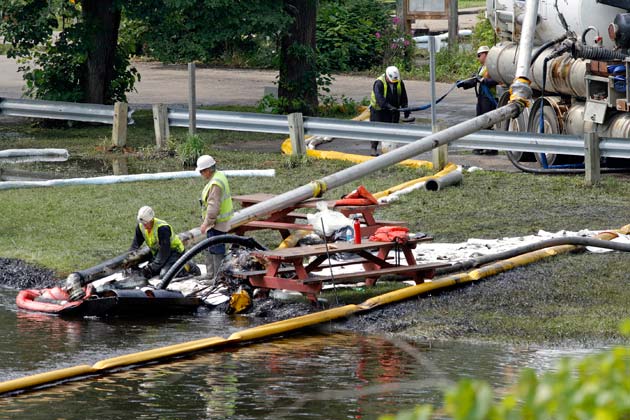US Congress moves toward tougher stand on pipeline safety--but is it enough?
By Lena Groeger in ProPublica
A bill to strengthen pipeline safety regulations passed the House and Senate last week and now awaits President Obama’s signature. But while many applaud Congress’s move toward more oversight, others question whether the impending law goes far enough to prevent oil and natural gas pipeline accidents.
The pipeline industry reports more than 100 significant hazardous liquid spills each year. (See a map of those spills). Every year, an average of 275 accidents kill 10 to 15 people and injure five to six times as many.
The “Pipeline Safety, Regulatory Certainty, and Job Creation Act of 2011” would double potential fines for violations (up to a max of $2 million), require automated shutoff valves for new and replaced pipelines, and hire 10 new safety inspectors to join the current 124.
“This is a huge step forward for the safety of America’s pipelines,” Senator Frank R. Lautenberg (D-NJ) said in a statement.
But as the Associated Press noted, the bill doesn’t implement several recommendations from a National Transportation Safety Board investigation of the natural gas pipeline explosion in San Bruno, California that killed eight people last September (the San Francisco Chronicle has a recent series on the disaster). One of those recommendations is that automated shutoff valves be installed on already existing pipelines (particularly old ones in highly populated areas, which are prone to accidents).
Safety experts also say that the Pipeline and Hazardous Materials Safety Administration, the federal agency responsible for regulating the vast network of 2.5 million miles of pipelines, needs many more inspectors to do the job right. The pipeline agency simply doesn’t have enough inspectors, or money to hire them, a New York Times investigation recently found.
A recent Congressional Research Service report on pipeline safety found a long-term pattern of understaffing. Which means that it’s often pipeline workers who notice and report problems – if they catch them in time.
In recent years, a series of major accidents have further raised the profile of dangerous pipelines. In addition to the San Bruno blast, 800,000 gallons of oil spurted into Michigan’s Kalamazoo River last July after a 30-inch pipeline sprung a leak. Another 42,000 gallons spilled in July into the Yellowstone River in Montana from a ruptured pipe.
Thousands of other pipelines could potentially share the same fate. More than 60 percent of the country’s gas pipelines are at least 40 years old, and they often aren’t compatible with the latest in safety technology (the Philadelphia Inquirer has a recent series on aging pipelines).
We’ve covered the recurring troubles with Alaska’s pipelines, which federal agencies have repeatedly flagged, urging repairs or entire replacements of dangerously corroded pipes. Even portions of the pipelines that BP inspectors didn’t give an “F” ranking (BP is the largest single owner of the Alaska pipelines) have burst, spewing thousands of gallons of oily water and methanol.
Another problem, as we’ve noted previously, is who writes the regulation standards. As it happens, the gas and oil industry has written at least 29 of the standards later adopted by the pipeline agency.
The bill comes alongside a Republican attempt to speed up the approval of the controversial Keystone XL Pipeline, a 1,700 mile long pipeline that would run from Canada to the Gulf of Mexico, carrying a particularly viscous form of crude called oil sands. As mentioned in the Times, the bill makes no reference to Keystone, but calls for more studies on whether oil sands needs extra regulation.






















